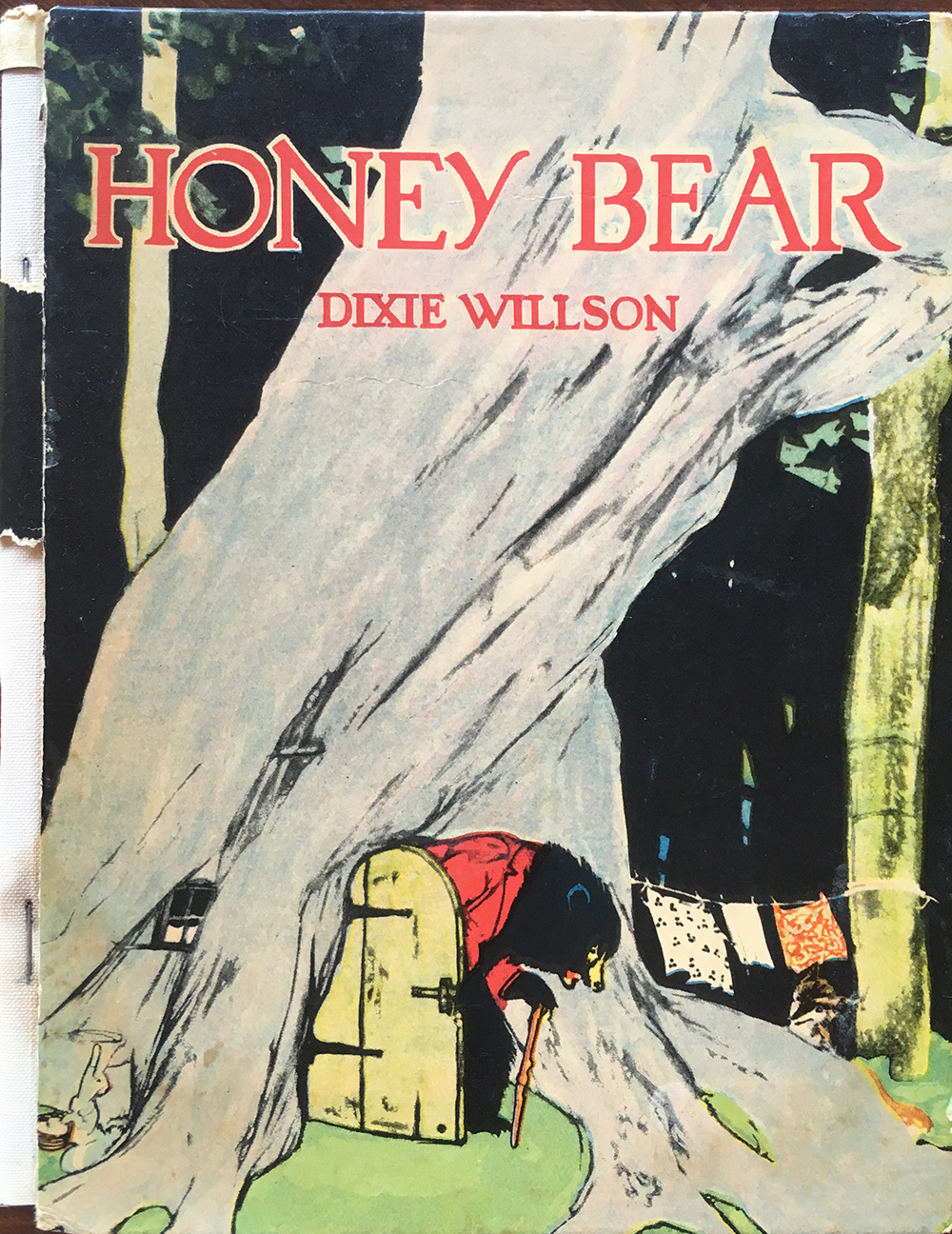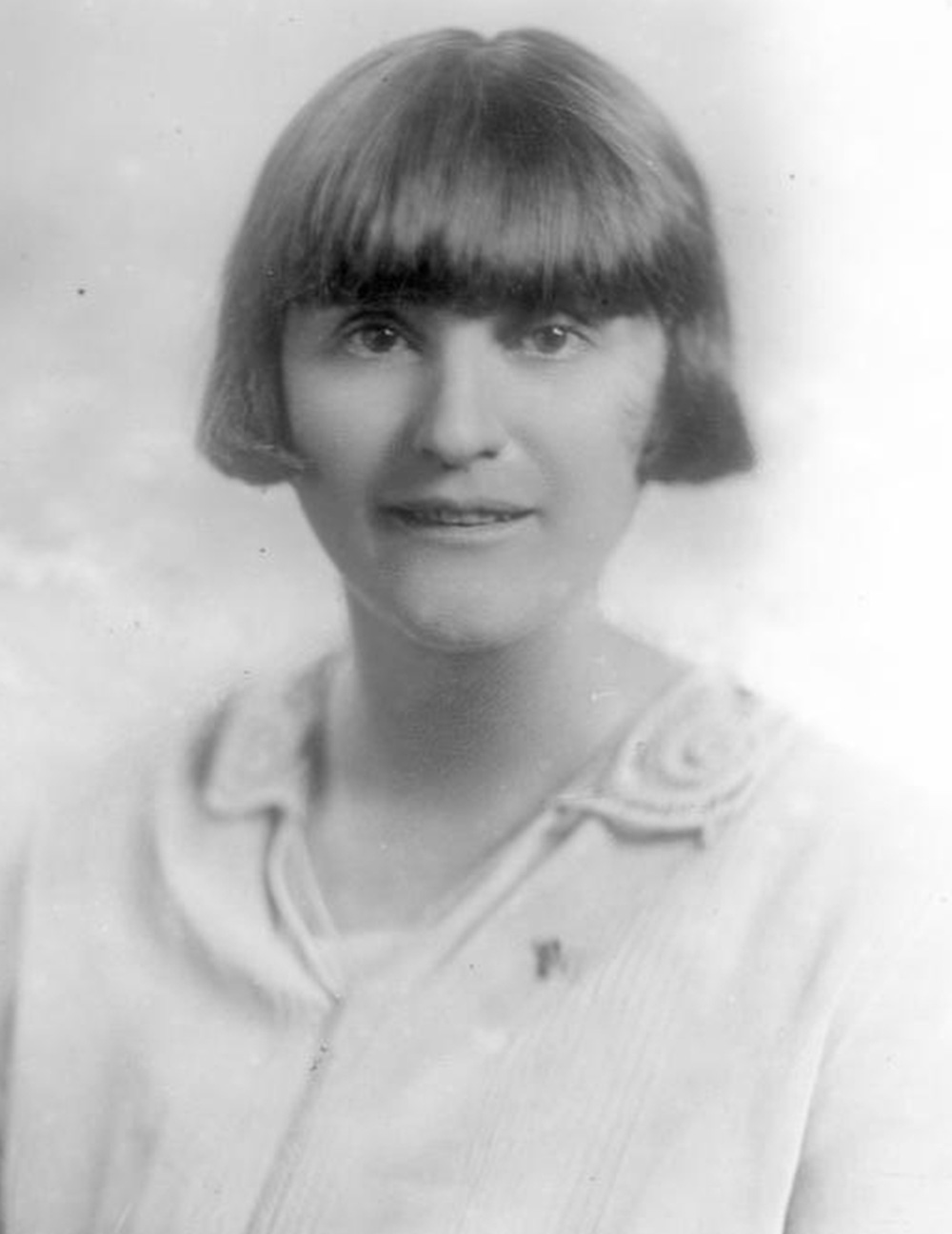One
children’s book I read to my four-year-old daughter always begins with a
preamble, even if she doesn’t approve: a brief note from Alice Ann
Blackmore, my grandmother, written in 1976 on the flyleaf of Dixie
Willson’s
Honey Bear. “It is a rare bit of sing-song for
children,” my grandma wrote of the book, which had been published in
1923, when she was just three years old, “as rare as Aunt Dixie herself.
Please be sure it stays in the family with whomever cares most about
it.” That, I tell Story, my daughter, is her. We then proceed to read
the tale of the “wildest thing of any in the dusky, rusky forest”—an old
black bear—and the little baby he may or may not plan to eat.
The woman my grandmother called her aunt was a relative through
friendship, not family. Born in 1890, Dixie Willson was the daughter of
John David and Rosalie Willson, who ran in the same society circles in
Mason City, Iowa, as my grandmother’s parents, Dwight Moore, president
of a local bank, and his wife, Stella. Willson’s younger brother, the
composer Meredith Willson, is best remembered today for writing
The Music Man. But there was a time, particularly during in the 1920s and 1930s, when Dixie was the most famous scion of this Iowa town.
The children’s books she wrote were just a piece of a career that was
as ambitious as it was unique, taking her from writing for both
Hollywood and magazines like
McClure’s and
Good Housekeeping
to working in the test kitchens at Betty Crocker and developing a toy
for children. Her adventures—which also included being a chorus girl in
the Ziegfeld Follies as well as being personally chosen by Howard Hughes
to write his never-completed biography,
Who’s Hughes?—were fodder both for her books and screenplays for films including
An Affair of the Follies (1927) and
God Gave Me 20 Cents (1926). Still,
Honey Bear
is the book Willson is best—if at all—remembered for. It’s a book that
my great aunt Ellen Moore still remembers with delight today, and one I
hope will leave a big impression on my own daughter.
But for the three young Moore sisters, Aunt Dixie was thrilling not
because of who she knew or what she had done but because of the fantasy
world she opened to them. “She used to tell us stories about a town in
southern Iowa called Vinton”—Willson’s own Winesburg, Ohio—said Ellen
Moore, who has survived her two sisters and remains sharp and
inquisitive at ninety-one. “We would just love it when she came. She was
so fun and lively, and she would have such a good time. I guess she was
making up stories as she told them to us. But maybe not—maybe the
stories already existed in her mind.”
My grandmother died in the winter of 2013. When we were clearing out
her house the next spring, I found two invitations from Aunt Dixie
asking Alice Ann to what Willson called a “kindergarten party.” The
yellowed onionskins were collaged over with drawings of children that
look as if they could have come from her own books, the typewritten
words spilling around the images. They resemble tiny works of art, as if
Hannah Höch were your babysitter. I was mildly curious about Willson
when my Aunt Kathy gave me the family copy of
Honey Bear after my daughter was born, but after I saw the invitations, I became fascinated:
I have a little friend named Floyd who is just as big as
you are and who has some red shoes, and some day he is coming to see me
and then we will both come and play with you if you think that would be
nice. And when he comes maybe you can come too and will have a
kindergarten party and my house and have chicken bones.
What kid wouldn’t want to go eat chicken bones with Aunt Dixie and Floyd with the red shoes?
Honey Bear is the story of
a big and black and boogy bear who steals a pinky, winky baby from a
cabin and takes it deep into the dusky, rusky forest. It’s not a book
with a product tie-in or a Disney spin-off—the kind of contemporary
kids’ book garbage that, if you’re like me, parents can occasionally
manage to read aloud while more asleep than awake. Whimsically
illustrated by Maginel Wright Barney (sister of Frank Lloyd Wright),
Honey Bear is
lyrically engaging, like the best of Dr. Seuss, but it’s far from being
nonsense. It is thrilling and funny, and it presents a much different
kind of morality tale than most children’s books.
 IMAGE:The author’s family copy of “Honey Bear.” Courtesy of Willy Blackmore.
IMAGE:The author’s family copy of “Honey Bear.” Courtesy of Willy Blackmore.
Fairy tales are, as a genre, object lessons of what not to do—don’t
stray from the trail, don’t disobey your mother—and modern children’s
books often conclude with less morbid lessons, like “Be inclusive” or
“Go the fuck to sleep.” But
Honey Bear is more adult in both
its morality and characterization, presenting a maybe-villain who is as
horrifying to the baby’s parents as he is attractive to the baby
herself. In Willson’s world, being kidnapped by a predator ends up being
a wonderful adventure, even if it sends her parents running into the
woods with guns. For (spoiler alert) the bear didn’t plan to eat the
baby after all but wanted to invite her to a party:
He had gone and found the baby in the teeney,
greeney garden
And had made an invitation in his very Sunday
best
And had taken her to help him have his funny
honey party—
Eating half of it himself and giving baby all the
rest!
While first editions of
Honey Bear can cost nearly $200 online, Willson’s work has not persisted in the same way as her brother Meredith’s has.
Honey Bear was recently republished by
Silver Birch Press, an independent press based in Los Angeles, but it is by no means widely available.
Dixie Willson started writing when she was a child herself: she contributed to her local paper, the Mason City
Globe Gazette,
at the age of ten, and won a national fiction-writing contest for
adults four years later. Her plays were produced by the local theater
company, and she eventually began to talk about moving to New York—a
plan her parents did not approve of. “They felt she would be happier and
better situated if she followed the career of most women, marriage and
motherhood,” reported the
Globe Gazette in 1941. “They persuaded their daughter that once she was settled down most of her ‘wild dreams’ would disappear.”
So Willson dutifully got married in 1915 but divorced a year later,
and she arrived in New York City in 1918 with $9. (She wouldn’t marry
again until 1945.) Eight years later, in 1926, she was profiled in
The New York Times,
which reported that she was by then earning $50,000 a year—nearly
$685,000 in 2017 dollars—writing stories that were adapted for films at
$10,000 a pop. She had a blonde bob with blunt-cut bangs, and wore a
white felt hat and a raccoon coat to her interview—a look reminiscent of
“a [J.M.] Barrie character.”
 IMAGE:Dixie Willson, c. 1930. German Federal Archive.
IMAGE:Dixie Willson, c. 1930. German Federal Archive.
The
Times profile—at once glamorizing and infantilizing,
making note of both her height (5'3") and appetite (“good”)—makes
Willson a bit of a manic-pixie dilettante. But as a journalist, she was
both highly skilled and determined in her reporting, often spending
extended periods of time immersed in the worlds she was writing about.
“When she wrote, she became what she wrote,” her daughter, Dana Willson
Briggs, told the Mason City
Globe Gazette in 2001. She wrote
about entertainment, broadly speaking, which was a beat that ran the
gamut from profiling Barbara Stanwyck for
Photoplay in 1937 to writing about her own experiences as a chorus girl. For Willson’s book
Where the World Folds Up at Night
(1932), which follows the Ringling Bros. and Barnum & Bailey
Combined Shows of the 1920s, she didn’t just interview people who had
joined the circus, she joined herself, becoming an elephant rider:
I was feverishly eager to be part of everything. I wanted
to swing from the highest trapeze. I wanted to enter the cage of the
fiercest lion. I wanted to try my mettle and measure my grit with the
rest. I wanted to fit into a place where that steady fearlessness and
never-failing courage would be required of me too. If a disregard, a
contempt, for the white feather were the only thing the circus has
taught me, I should consider it, for that alone, a magnificent
association.
Later she attended Trans World Airline’s stewardess school in order to write
Hostess of the Skyways
(1941), about the women who attended to the rich travelers of the
golden age of flying. Her wild dreams simply would not, as her parents
had suggested, simply disappear.
The most significant literary influence Willson has had involves
Tom Wolfe,
surprisingly. It wasn’t that the lived-in style of reporting she
practiced helped beget New Journalism—it was again because of
Honey Bear. Her writing “galvanized” a young Wolfe, he told
Yale Alumni Magazine in 2003. “
Honey Bear’s
main attraction was Dixie Willson’s rollicking and rolling rhythm:
anapestic quadrameter with spondees at regular intervals”—a rhythm that,
as both Wolfe and every other person I have showed the book agree,
nearly demands to be read out loud:
He would growl and he would grumble, he would
snuffle at the flowers!
He was big and black and boogy, and the neighbor
children said,
If they ever went a-playing in the dusky ruksy
forest
And they found his big old bear-tracks they’d go
scooting home instead!
“I had memorized the entire poem in the passive sense that I could
tell whenever Mother skipped a passage in the vain hope of getting the
110th or 232nd reading over with a little sooner,” he wrote. “Oh,
no-ho-ho…there was no fooling His Majesty the Baby. He wanted it all. He
couldn’t get enough of it.”
Despite being such a galvanizing force in Wolfe’s life as a writer,
he called Willson “a writer who never rated so much as a footnote to
American literary history.” Yet his own books suggest otherwise: every
one of his books contains an homage to her work. Look at the very
beginning of
The Right Stuff, when Wolfe describes Pete
Conrad’s cottage as being set among a stand of pines “with a thousand
little places where the sun peeks through”—which is just how Willson
describes the woods where
Honey Bear takes place.
Similar lines can be found throughout Wolfe’s work. “I’ve slipped a phrase or two from
Honey Bear into every book I’ve written,” he said. Willson, in turns out, rates at least a footnote—though she deserves much more.
 It would’ve been Dorothy Parker’s 134th
birthday last Tuesday. The legendary writer, critic and poet didn’t
quite live to such an advanced age, but she packed a punch in the
seventy-three years she did spend on this earth. Her legacy is
all-encompassing: Parker’s name isn’t limited to the pages of the
publications she was a part of. She was one of the founding members of
the Algonquin Round Table, and The New Yorker; an Oscar-nominated playwright, and a professor of English.
It would’ve been Dorothy Parker’s 134th
birthday last Tuesday. The legendary writer, critic and poet didn’t
quite live to such an advanced age, but she packed a punch in the
seventy-three years she did spend on this earth. Her legacy is
all-encompassing: Parker’s name isn’t limited to the pages of the
publications she was a part of. She was one of the founding members of
the Algonquin Round Table, and The New Yorker; an Oscar-nominated playwright, and a professor of English.



